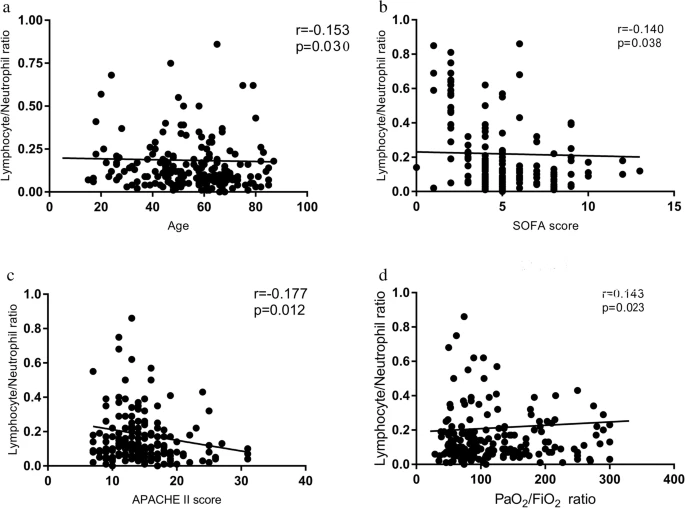- BMC Pulmonary Medicine
- Research article
- Open Access
Abstract
Background
 |
| Relationships between the lymphocyte/neutrophil ratio and age, APACHE II score, SOFA score, and PaO2/FiO2 ratio in ARDS patients |
Risk factors affecting the prognosis of acute respiratory distress syndrome (ARDS) in adults were investigated. The aim was to identify new predictors for ARDS patient prognosis, including those with clinical, pathophysiological, and atypical immunodeficiency.
Methods
ARDS patients were retrospectively included. The patients were grouped and analysed according to different oxygenation index grades and prognosis, and factors influencing prognosis and survival were examined. Adolescent patients, patients with typical immunodeficiency and patients who died within 24 h after being diagnosed with ARDS were excluded. The predictive value for mortality was determined by Cox proportional hazard analysis.
Results
In total, 201 patients who fulfilled the Berlin definition of ARDS were included. The severity of critical illness on the day of enrolment, as measured by the Acute Physiology and Chronic Health Evaluation (APACHE) II score (P = 0.016), Sequential Organ Failure Assessment (SOFA) score (P = 0.027), and PaO2/FiO2 (P = 0.000), worsened from mild to severe ARDS cases. Compared with survivors, non-survivors were significantly older and had higher APACHE II and SOFA scores. Moreover, significantly lower lymphocyte/neutrophil ratios and leukocyte counts were found among non-survivors than survivors (P = 0.008, P = 0.012). A moderate positive correlation between the lymphocyte/neutrophil and PaO2/FiO2 ratios (P = 0.023) was observed. In predicting 100-day survival in patients with ARDS, the area under the curve (AUC) for the lymphocyte/neutrophil ratio was significantly higher than those for the PaO2/FiO2 ratio alone, body mass index (BMI) alone, and the lymphocyte count alone (P = 0.0062, 0.0001, and 0.0154). Age (per log10 years), BMI < 24, SOFA score, leukocyte count, and the lymphocyte/neutrophil ratio were independent predictors of 28-day mortality in ARDS patients. Additionally, ARDS patients with a lymphocyte/neutrophil ratio < 0.0537 had increased 28-day mortality rates (P = 0.0283). Old age affected both 28-day and 100-day mortality rates (P = 0.0064,0.0057).
Conclusions
Age (per log10 years), BMI < 24, SOFA score, lymphocytes, and the lymphocyte/neutrophil ratio were independent predictors of 100-day mortality in patients with ARDS. The lymphocyte/neutrophil ratio may represent a potential molecular marker to evaluate atypical immunosuppression or impairment in patients with ARDS.
No comments:
Post a Comment